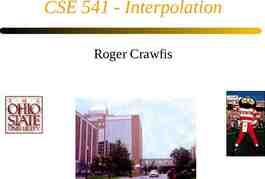Best Practices for Managing PPP & EIDL funding through QuickBooks Live
16 Slides4.90 MB
Best Practices for Managing PPP & EIDL funding through QuickBooks Live Webinar will begin shortly 5/27/2020 9:00 am 1
Speaker SCORE Chapter’s CFO & Workshop Volunteer 2
Disclaimer The information provided is based upon facts that were available at the time of publication and are subject to change. We make no warranties, express or implied, or representations as to the accuracy, completeness or timeliness of the information provided. We cannot be held liable for any claims or damages that result from reliance on this information. Neither SCORE or SCORE Mentors provide legal or accounting advice. This presentation provides a general overview of the subject matter. You should seek advice from your lawyers, accountants and other advisor regarding the specifics of your business. to the accuracy, completeness or timeliness of the information provided. NOW CFO cannot be held liable for any claims or damages that result from reliance on this information. 3
Managing Your QuickBooks to Chart Your Company's Crisis Recovery Points to be discussed 1. What will banks be asking to obtain forgiveness? 2. How to track PPP and EIDL expenses? (LIVE DEMONSTRATION) 3. How to obtain forgiveness? (Will be covered next week on 6/3/2020 at 9am) 4
Managing Your QuickBooks to Chart Your Company's Crisis Recovery Documents that Each Borrower Must Submit with its PPP Loan Forgiveness Application Payroll: Documentation verifying the eligible cash compensation and non-cash benefit payments from the Covered Period or the Alternative Payroll Covered Period consisting of each of the following: a. Bank account statements or third-party payroll service provider reports documenting the amount of cash compensation paid to employees. b. Tax forms (or equivalent third-party payroll service provider reports) for the periods that overlap with the Covered Period or the Alternative Payroll Covered Period: i. Payroll tax filings reported, or that will be reported, to the IRS (typically, Form 941); and ii. State quarterly business and individual employee wage reporting and unemployment insurance tax filings reported, or that will be reported, to the relevant state. c. Payment receipts, cancelled checks, or account statements documenting the amount of any employer contributions to employee health insurance and retirement plans that the Borrower included in the forgiveness amount (PPP Schedule A, lines (6) and (7)). 5
Managing Your QuickBooks to Chart Your Company's Crisis Recovery Documents that Each Borrower Must Submit with its PPP Loan Forgiveness Application FTE: Documentation showing (at the election of the Borrower): a. the average number of FTE employees on payroll per month employed by the Borrower between February 15, 2019 and June 30, 2019; b. the average number of FTE employees on payroll per month employed by the Borrower between January 1, 2020 and February 29, 2020; or c. in the case of a seasonal employer, the average number of FTE employees on payroll per month employed by the Borrower between February 15, 2019 and June 30, 2019; between January 1, 2020 and February 29, 2020; or any consecutive twelve-week period between May 1, 2019 and September 15, 2019. The selected time period must be the same time period selected for purposes of completing PPP Schedule A, line 11. Documents may include payroll tax filings reported, or that will be reported, to the IRS (typically, Form 941) and state quarterly business and individual employee wage reporting and unemployment insurance tax filings reported, or that will be reported, to the relevant state. Documents submitted may cover periods longer than the specific time period. 6
Managing Your QuickBooks to Chart Your Company's Crisis Recovery Documents that Each Borrower Must Submit with its PPP Loan Forgiveness Application Nonpayroll: Documentation verifying existence of the obligations/services prior to February 15, 2020 and eligible payments from the Covered Period. a. Business mortgage interest payments: Copy of lender amortization schedule and receipts or cancelled checks verifying eligible payments from the Covered Period; or lender account statements from February 2020 and the months of the Covered Period through one month after the end of the Covered Period verifying interest amounts and eligible payments. b. Business rent or lease payments: Copy of current lease agreement and receipts or cancelled checks verifying eligible payments from the Covered Period; or lessor account statements from February 2020 and from the Covered Period through one month after the end of the Covered Period verifying eligible payments. c. Business utility payments: Copy of invoices from February 2020 and those paid during the Covered Period and receipts, cancelled checks, or account statements verifying those eligible payments. 7
Managing Your QuickBooks to Chart Your Company's Crisis Recovery LIVE DEMONSTRATION 8
Q&A 9
THANK YOU! Visit santabarbara.score.org! Business Resources / Workshops and Webinars / Free Mentoring 10
Managing Your QuickBooks to Chart Your Company's Crisis Recovery Some basic definitions Balance Sheet - Measures results at a point in time (What you own, what you owe & net worth) Profit and Loss/Income Statement – Measures results over a period of time Statement of Cash Flows - Tells you how much cash is entering and leaving your business Accrual Basis - Matches revenue and expense to the period they are incurred Cash Basis – Matches revenue and expense when they are received or paid 11
Managing Your QuickBooks to Chart Your Company's Crisis Recovery What does it mean to have “clean books”? Your Accounts Receivable Aging is accurate. Customer balances are true. Your Accounts Payable is accurate. Vendor payments are not duplicated. You can verify your assets including fixed asset accounts. Depreciation for fixed assets are not missing and are consistent. Vacation or PTO accruals are not missing or inaccurate. The only uncleared or unreconciled transactions are those waiting to clear the bank. You can proof liability balances with a credit card/loan statement and a promissory note. Non-cash expenses are accounted for. (Personal Contributions/Owner’s Draws) 12
Managing Your QuickBooks to Chart Your Company's Crisis Recovery What are your bookkeeping processes? Sales/Income Accounts Receivable(A/R) Invoice Customer Payment Deposit Direct Sales Sales Receipts Deposits Expenses Accounts Payable Bill Bill Payment Receipts Debit, checks, credit cards, cash Payroll Timecards Paychecks Payroll Liabilities Quarterly Forms Annual Forms Other Income / Other expenses Non-cash expenses 13
Managing Your QuickBooks to Chart Your Company's Crisis Recovery What are your bookkeeping processes? Reconciling Bank accounts Credit Card accounts Loans accounts or loan from others Verifying Assets Existing equipment/vehicles/furniture Loans to others (employee advances) Security Deposits Verifying Liabilities Credit Card balances Payroll Liabilities Sales Taxes Liabilities Loans from others Verifying Equity Credit Card balances Payroll Liabilities 14
Managing Your QuickBooks to Chart Your Company's Crisis Recovery What is the true health of your business? How much money is in the bank? Are there any outstanding checks that haven’t cleared? Is there any cash that is forecast to come in over the next week (are there any ARs being collected)? How much in AP (accounts payable) is due in the next week? 15
Managing Your QuickBooks to Chart Your Company's Crisis Recovery What is the true health of your business? Analyze your numbers What are your numbers telling you? For every 100 you bring in, how much are you using for COGS, Expenses, and overall Profit/Loss. (This will be like taking your temperature, blood pressure and weight at the doctor’s office) Act Fast What changes need to happen to improve or reduce profit/loss (When doctor’s check your temperature, they don’t just go “whoa, she has a 103o temperature” No they do something about it.) Act appropriately. Zero in on what will make a difference Although a lot of data need to be analyzed, focus on areas that will make your business move forward. What moves or investments will really make the difference? (Marketing, New Products, etc) Be Cautious of “Alarm” Fatigue If your numbers tell you something is wrong don’t ignore. We tend to do this to avoid the complexity of the situation, however taking care of items as soon as possible will allow for better business development and opportunity. 16





















